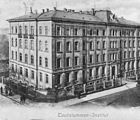Karl Sudhoff Institute

The Karl Sudhoff Institute , full name Karl Sudhoff Institute for the History of Medicine and Natural Sciences , is an institution at the Medical Faculty of the University of Leipzig . Founded in 1906, it is the oldest medical history institute in the world, named after its founder Karl Sudhoff (1853–1938).
story
In 1899, the Viennese medical historian Theodor Puschmann (1844–1899), who had completed his habilitation in Leipzig, left the University of Leipzig with significant endowment to promote research in medical history. After a few arguments with Puschmann's heirs, the Institute for the History of Medicine in Leipzig was the first in the world to open on April 1, 1906. Karl Sudhoff, who was appointed extraordinary professor in 1905 and who had previously worked as a metallurgical doctor at the Hochdahl ironworks , was appointed director of the institute with a staff member . As early as 1904 he was at the Medical Academy in Düsseldorf as an extraordinary professor of medical history been appointed.
The institute was located in seven rooms in Talstrasse 35, into which the Mathematical Institute had moved in 1905 as the successor to the physical. Most of the rooms served as a library. In 1909, the Mathematical Institute's own needs made it necessary to move to the neighboring Zoological Institute, Talstrasse 33. This was followed in 1915 by a move to the ground floor of the former deaf-mute institute , Talstrasse 38, which was used by various university institutes after the move to the new deaf-mute institute in Karl-Siegismund-Strasse.
- Former quarters of the institute
In 1913 Sudhoff became an honorary professor ; His endeavors for an ordinariate as a sign of the equality of medical history with other medical disciplines were not fulfilled until 1919. In 1925 Karl Sudhoff retired , but continued to work at the institute. His successor was the Swiss Henry Ernest Sigerist (1891–1957), who was now also assisted by assistants, including Johann Daniel Achelis (1898–1963), Walter Pagel (1898–1983) and Owsei Temkin (1902–2002). A secretary and a librarian who had to cope with an annual increase in books of 1,000 volumes also belonged to the institute under Sigerist.
In 1932 Henry Ernest Sigerist took over the management of the Institute for the History of Medicine at Johns Hopkins University in Baltimore ( USA ). After a two-year interregnum , Walter von Brunn (1876–1952) became director in Leipzig; he also led the institute through World War II and the difficult period after it. But first of all a move was planned again in 1936. The institute received 20 rooms again in the zoological institute. The library now had 25,000 volumes. The most valuable of these were stored in 144 boxes in corridors under Mutzschen Castle in 1943, from where they were brought to the Soviet Union after the war . Requests for return were unsuccessful.
At Christmas 1938, at the suggestion of Brunns, the institute was renamed the Karl Sudhoff Institute for the History of Medicine and Natural Sciences , an honor that Karl Sudhoff lost for about two months. The zoological institute was damaged in the war, but it was difficult to restart the institute afterwards. The previous domicile in the deaf-mute institute was totally destroyed.
Under the directors who followed from 1950, the history of the natural sciences became increasingly important. A second ordinariate was created. Both professors were to take over as directors every two years. This did not happen because the physicist Gerhard Harig (1902-1966) , who was nominated alongside the internist Felix Boenheim (1890-1960), went to Berlin as State Secretary for higher education until 1957 .
The upheavals at the university in the course of German reunification existed at the Karl Sudhoff Institute, combined with a reduction in staff, especially on the part of the history of the natural sciences. The move in 1990 to the main building of the university on Augustusplatz led to a loss of space and the associated relocation of a large part of the library holdings.
When it was time to demolish the university building for the new Augusteum in 2006 , the institute was given a new domicile in Käthe-Kollwitz-Strasse in the former villa of the publisher Herrmann Julius Meyer (1826–1909).
Institute
The Karl Sudhoff Institute, headed by Ortrun Riha since 1996, with the departments of History of Medicine and History of Natural Sciences , conducts teaching and research. It is responsible for the medical history training of human, dental and veterinary medicine students. In addition, there is the medical terminology for students without knowledge of Latin. Currently (2020) there are research topics on German-Russian scientific relations of the 18th and 19th centuries as well as on homeopathy in Russia.
The institute's library, which Karl Sudhoff had already started to build with funds from the Puschmann Foundation, was constantly being expanded. In 1994 it had a volume of 70,000 volumes on a shelf length of 1,200 meters. At that time it was assigned to the Central Medicine Library of the Leipzig University Library . Finally, in 2018 the older volumes were transferred to the Bibliotheca Albertina and the newer titles to the Central Medicine Library in Liebigstraße, so that the library of the Karl Sudhoff Institute no longer exists as such.
- Historical medical instruments on postage stamps
Sudhoff had also started the collection of historical medical evidence, which was continued by his successors. These are primarily medical instruments or instrument sets from the end of the 19th and the beginning of the 20th century, but also in some cases going back to the 16th century, and up to replicas from the Roman period of objects in other collections. The objects are recorded in a database, which in 2005 had over 4,600 entries. Numerous exhibitions have been organized with the objects so far. There is also a portrait collection with representations of around 6,400 medical professionals in the form of reproductions and photos. Up to 1998, this also included around 880 original graphics with portraits of doctors, which have since been properly stored in the custody of Leipzig University .
Directors
- 1906–1925: Karl Sudhoff
- 1925–1932: Henry Ernest Sigerist
- 1932–1950: Walter von Brunn
- 1950–1957: Felix Boenheim
- 1957–1966: Gerhard Harig
- 1966–1969: Hans Wußing (provisional)
- 1969–1977: Stanislaw Schwann
- 1977–1982: Hans Wussing
- 1982-1996: Achim Thom
- since 1996: Ortrun Riha
literature
- Horst Riedel, Thomas Nabert (ed.): Stadtlexikon Leipzig from A to Z . 1st edition. Pro Leipzig, Leipzig 2005, ISBN 3-936508-03-8 , pp. 284 .
- Achim Thom, Ortrun Riha (Ed.): 90 years of the Karl Sudhoff Institute at the University of Leipzig . Leipzig: Karl Sudhoff Institute 1996
- Ortrun Riha (Ed.): 100 Years of the Karl Sudhoff Institute for the History of Medicine and the Natural Sciences . Shaker Verlag, Aachen 2016, ISBN 978-3-8322-4920-5
Web links
- Institute website. Retrieved November 27, 2020 .
Individual evidence
- ↑ 100 years of the Karl Sudhoff Institute. In: Website of the Leipzig University Library. Retrieved December 3, 2020 .
- ↑ Riha: 100 Years ... , p. 27
- ↑ Thom / Riha: 90 years ... , pp. 56–59
- ↑ Thom / Riha: 90 years ... , p. 36
- ↑ Thom / Riha: 90 years ... , p. 64
- ↑ Medical history collection. In: Institute's website. Retrieved December 2, 2020 .
- ↑ Riha: 100 Years ... , p. 83
Coordinates: 51 ° 20 ′ 2.9 " N , 12 ° 21 ′ 10.4" E





